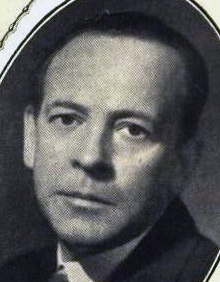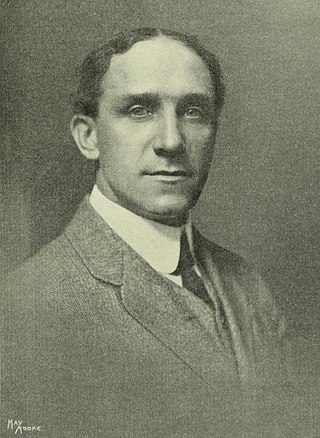
Gladys Lillian Moncrieff was an Australian singer who was so successful in musical theatre and recordings that she became known as 'Australia's Queen of Song' and 'Our Glad'.
Efftee Studios was an early Australian film and theatre production studio, established by F.W. Thring in 1930. It existed until Thring's death in 1935. Initially Efftee Films was based in Melbourne and used optical sound equipment imported from the US.
George Stephenson "Onkus" Wallace, was an Australian comedian, actor, vaudevillian and radio personality. During the early to mid-20th century, he was one of the most famous and successful Australian comedians on both stage and screen, with screen, song and revue sketch writing amongst his repertoire. Wallace was a small tubby man with goggle eyes, a mobile face and croaky voice who appeared in trademark baggy trousers, checkered shirt and felt hat. His career as one of Australia's most popular comedians spanned four decades from the 1920s to 1960 and encompassed stage, radio and film entertainment. Ken G. Hall, who directed him in two films, wrote in his autobiography that George Wallace was the finest Australian comedian he had known.

The Princess Theatre, originally Princess's Theatre, is a 1452-seat theatre in Melbourne, Victoria, Australia. Established in 1854 and rebuilt in 1886 to a design by noted Melbourne architect William Pitt, it is the oldest surviving entertainment site on mainland Australia. Built in an elaborate Second Empire style, it reflects the opulence of the "Marvellous Melbourne" boom period, and had a number of innovative features, including state of the art electric stage lighting and the world's first sliding ceiling, which was rolled back on warm nights to give the effect of an open-air theatre.

Frank Harvey was a British-born actor, producer, and writer, best known for his work in Australia.
His Royal Highness is a 1932 Australian musical film directed by F. W. Thring, also known as His Loyal Highness, starring George Wallace in his feature film debut. It was the first Australian film musical.
Independent Theatre, formerly known as The Independent Theatre Ltd., was an Australian dramatic society founded in 1930 by Dame Doris Fitton in Sydney, Australia. It is also the name given to the building it occupied from 1939, now owned by Wenona School, in North Sydney, cited as Sydney's oldest live theatre venue.
Harmony Row is a 1933 Australian musical comedy directed by F. W. Thring and starring popular stage comedian George Wallace. It marked the film debut of Bill Kerr.
A Ticket in Tatts is a 1934 musical comedy film starring popular stage comedian George Wallace as an accident-prone stablehand. It was the last of three films Wallace made for F. W. Thring.

Francis William Thring III, better known as F. W. Thring, was an Australian film director, producer, and exhibitor. He has been credited with the invention of the clapperboard.
Diggers is a 1931 Australian comedy film produced and directed by F. W. Thring starring popular stage comedian Pat Hanna. It was the first feature film from both men.

The Streets of London is a 1934 Australian film directed by F. W. Thring. It was a filmed version of a play by Dion Boucicault which Thring had produced on stage the previous year. It was the last film made by Efftee Film Productions – Thring ceased production afterwards with the aim of resuming it later but died in 1936 before he had the chance.
Clara Gibbings is a 1934 Australian film directed by F.W. Thring about the owner of a London pub who discovers she is the daughter of an earl. It was a vehicle for stage star Dorothy Brunton.
The Sentimental Bloke is a 1932 Australian film directed by F. W. Thring and starring Cecil Scott and Ray Fisher. It is an adaptation of the 1915 novel Songs of a Sentimental Bloke by C. J. Dennis, which had previously been filmed in 1919.
The Cedar Tree is an Australian musical play produced in the wake of the success of Collits' Inn. The 1934 Melbourne production at the Princess Theatre was presented by F. W. Thring and starred Gladys Moncrieff.

Varney Monk was an Australian pianist and composer, best known for writing the musicals Collits' Inn (1932) and The Cedar Tree (1934). Collits' Inn was described by the Sydney Morning Herald as "an Australian opera".
William Hatfield (1892–1969) was the pen name of Ernest Chapman, an English-born writer best known for his work in Australia.
Blue Mountain Melody is a 1934 Australian musical comedy. The musical is set in and around Sydney, Australia; with scenes in the Blue Mountains, New South Wales, Palm Beach, New South Wales, and Kings Cross, New South Wales. It was a rare local musical produced by J. C. Williamson Ltd. The firm commissioned it following the success of Collits' Inn.

Hugh Joseph Ward was an American-born stage actor who had a substantial career in Australia as comic actor, dancer, manager and theatrical impresario.
Henry Osborne Jacobs was an English musician best known as an accompanist, arranger and conductor for Ada Reeve, then settled in Australia, where he had a substantial career.







